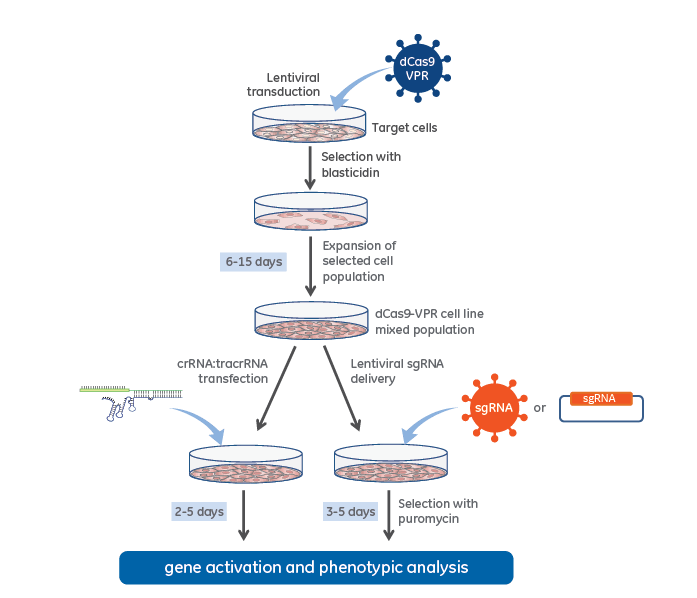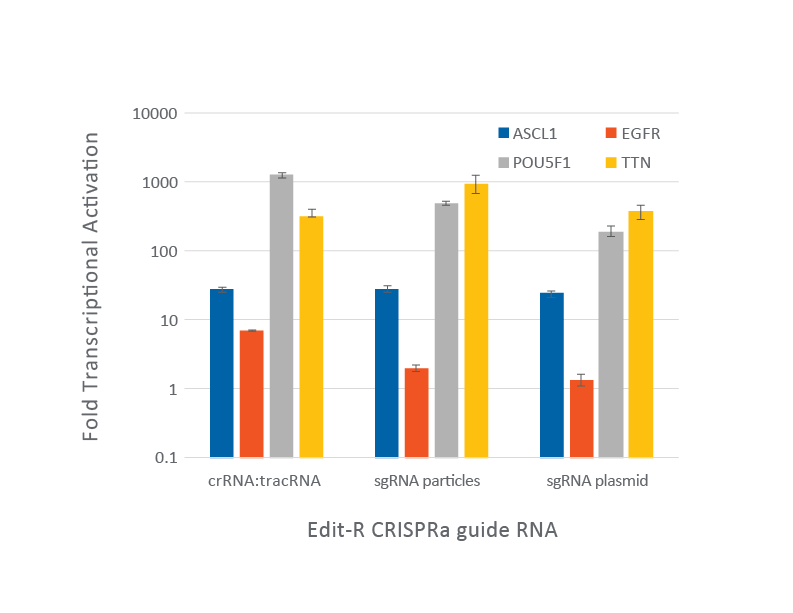- CRISPR activation reagents
- CRISPRa lentiviral sgRNA positive controls
CRISPRmod CRISPRa lentiviral sgRNA positive controls.

CRISPRa lentiviral sgRNA positive controls are designed to specifically activate the human and mouse Titin (TTN) or POU class 5 homeobox 1 (POU5F1) genes. It is recommended that positive controls always be used to optimize experimental conditions and included in every gene activation experiment to confirm successful delivery and dCas9-VPR activity.
The level of activation observed will depend on your cell type and basal level of expression. If either TTN or POU5F1 is already expressed in your cells, there will be more modest activation than with a gene that is not expressed. Normalization of the activation level to a non-targeting control will provide a baseline for determining optimal dCas9-VPR expression, transfection efficiency, and timepoint for your assay.
Highlights
- Species-specific lentiviral sgRNAs targeting the TTN and POU5F1 genes
- Available as high-titer purified lentiviral particles (50 µL at ≥ 1 x 108 TU/mL) or glycerol stocks
- Ideal for optimization of experimental conditions and confirming successful gene activation
CRISPRa workflow diagram with stable dCas9-VPR expression

CRISPR activation workflow with lentiviral dCas9-VPR and synthetic crRNA:tracrRNA (left side) or Lentiviral expressed sgRNA (right side).
CRISPRa plasmid co-transfection workflow

CRISPRa workflow for plasmid co-transfection of lentiviral dCas9-VPR and expressed sgRNA.
Efficient transcriptional gene activation with lentiviral sgRNA in dCas9-VPR stable cells

U2OS, HEK293T, MCF 10A and K562 stably expressing integrated CRISPRa dCas9-VPR were plated at 10,000 cells/well and transduced with CRISPRa sgRNA lentiviral particles targeting POU5F1 or TTN at a MOI of 0.3 to obtain cells with a single integrant. Cells were selected with 2 µg/mL puromycin for 4 days prior to analysis with RT-qPCR. The relative expression of each gene was calculated with the Cq method using GAPDH as the housekeeping gene and normalized to a non-targeting control.
Comparable activation is achieved with different CRISPRa guide RNA types

CRISPRa using synthetic crRNA:tracrRNA: Cells were plated at 10,000 cells/well and were transfected using DharmaFECT 4 Transfection Reagent with CRISPRa synthetic crRNA:tracrRNA (25 nM) targeting ASCL1, EGFP, POU5F1 and TTN genes. Cells were harvested 72 hours post-transfection and the relative gene expression was calculated using RT-qPCR. The relative expression of each gene was Cq method using GAPDH as the housekeeping gene and normalized to a non-targeting control.
CRISPRa with lentiviral sgRNA transduction: Cells were plated at 10,000 cells/well and were transduced with CRISPRa sgRNA lentiviral particles targeting ASCL1, EGFR, POU5F1 or TTN at a MOI of 0.3 to obtain cells with a single integrant. Cells were selected with 2 µg/mL puromycin for 4 days prior to analysis with RT-qPCR. The relative expression of each gene was calculated with the Cq method using GAPDH as the housekeeping gene and normalized to a non-targeting control.
CRISPRa with lentiviral sgRNA plasmid transfection: cells were plated at 10,000 cells/well and transfected with CRISPRa sgRNA plasmids (100 ng) targeting ASCL1, EGFR, POU5F1 or TTN using DharmaFECT kb Transfection Reagent. Cells were harvested 72 hours post-transfection (without puromycin selection) and the relative gene expression was calculated using RT-qPCR. The relative expression of each gene was Cq method using GAPDH as the housekeeping gene and normalized to a non-targeting control.
Safety data sheets
Related Products
Predesigned CRISPRa lentiviral sgRNAs for highly efficient gene activation in human and mouse models; available as glycerol stocks and high-titer purified particles.
Lentiviral sgRNA constructs bioinformatically designed and validated to not target any gene in human or mouse genomes.
Purified lentiviral particles or plasmid DNA for generation of stable dCas9-VPR nuclease-expressing cell populations
